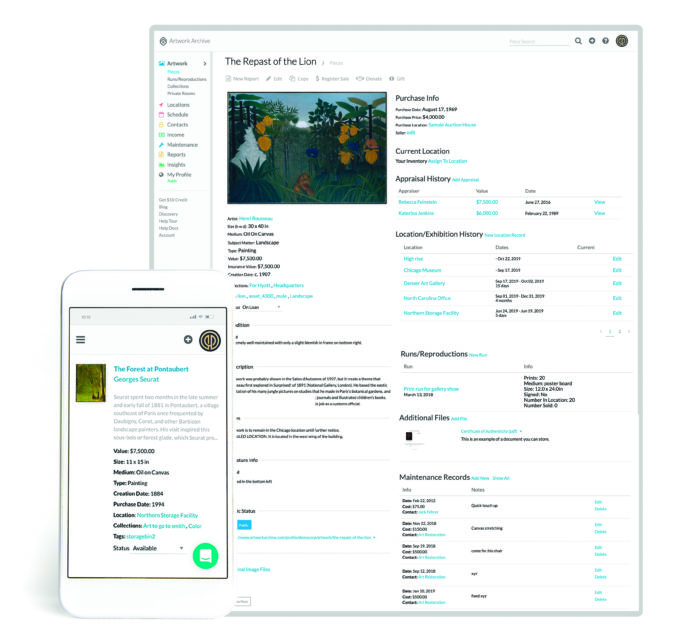How to Inventory Your Art Collection > Even seasoned collectors may not realize how disorganized their records are. We buy art, we enjoy it, the years roll by, and suddenly we have a home full of treasures not inventoried properly. Our accountants would not let us “get away” with this if these assets were bonds, but artworks often mystify them.
For those of us who don’t have a professional art adviser, now is the time to banish the disorder. Some of us are planning our estates, or documenting our possessions so the insurance company will know how much to compensate for damages after the next natural disaster. Others of us are just curious to remember exactly what we have — to go down Memory Lane and recall the moment when we acquired that special artwork.
For any of these objectives, find an easy-to-use inventory system. Artwork Archive is a Denver-based firm of artists, entrepreneurs, developers, writers, and designers collaborating since 2010 to give artists, collectors, and organizations better ways of managing their art. Led by Justin Anthony and John Feustel, this outfit launched one of the first cloud-based art inventory systems and now serves clients in 130 countries.
This initiative launched under less than ideal circumstances. When the collector Justin Anthony’s basement flooded, he did not have a clear handle on which works were actually down there. While researching his options for the future, he realized that most commercially available software systems were either too costly or too complicated for a “regular person” to run. Because necessity is the mother of invention, he and John Feustel created their own, and in 2020 marked their 10th anniversary.
Embracing the Details for Your Art Collection
The most important field in any artwork’s profile is its title. Once it’s established, everything else falls into place: you can then input the size, materials, date, source, condition (including damage caused by the movers), and location inside your home — right down to which wall it’s hanging on. The system makes it possible to scan and upload relevant documents such as purchase receipts, certificates of authenticity, and appraisal histories, and there are fields for works already sold or donated. The notes field allows users to, for example, reminisce about how the artwork was acquired.
It is easy to share all (or parts) of your Artwork Archive account with professionals who work with you. For example, the attorney handling your estate can be shown fields to do with which artworks go to which heir or museum. This is accomplished by running a customized report for him or her, or by granting access to relevant parts of the system to trusted attorneys, insurers, advisers, assistants, and dealers. These individuals can make changes or notations in your records, or they can have read-only rights.
As one should expect of any data-set software, reports can be sorted and run in various formats: lists, illustrated lookbooks, pie charts, and graphs — digitally, on paper, and for downloading to your hard drive. The system even allows you to print a customized gummed label (on Avery products) that can be adhered to the back of your artwork.
Artwork Archive users have the capacity to create private “viewing rooms” where all or some of their works can be “visited” by selected outsiders. Anthony adds that just under 10 percent of his clients take this further by creating a public profile that makes their collection searchable on Google.
A Small Marketplace
Artwork Archive is not the only firm active in this space, though it is the least expensive and most user-friendly. Large galleries, museums, artist-endowed foundations, advisers, contract registrars, and other art professionals also turn to such providers as Gallery Systems (founded in 1981), Artsystems (1989), Artlogic (1994), and Collector Systems (2003).
These firms are experienced in integrating the inventory system to websites and auction consolidator databases (such as 1stdibs) and, for commercial art galleries, to the tracking of which artworks are sold. These services are generally not needed by most private collectors, yet are worth knowing about.
How do you inventory your art collection? Share it with us in the comments below.
> Visit EricRhoads.com to learn about more opportunities for artists and art collectors, including retreats, international art trips, art conventions, and more.
> Sign up to receive Fine Art Today, our free weekly e-newsletter
> Subscribe to Fine Art Connoisseur magazine, so you never miss an issue









I am using Excel to inventory my art and antiques. but that doesn’t include a photograph which are held separately in a photo file. Not the easiest but just found your info today. I may be interested in a new file system. I do have everything identified with reference numbers in catalog raisonnes.